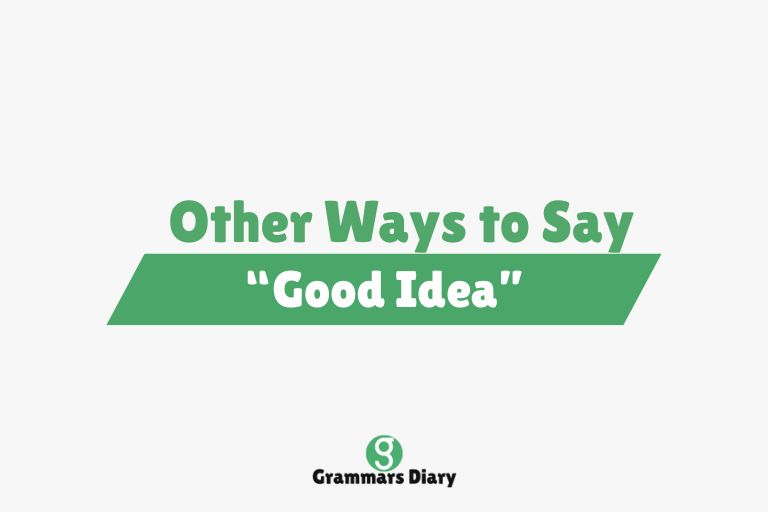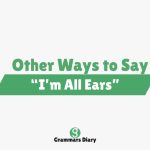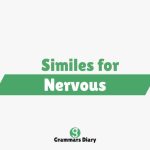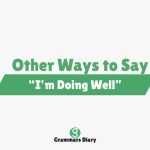“Good idea” is one of the most common phrases used in English when someone wants to show agreement, appreciation, or approval of a suggestion, plan, or proposal. Whether you’re talking to a friend, colleague, or teacher, saying “Good idea” communicates positive feedback and support. But repeating the same phrase in every situation can feel monotonous or lacking in variety, especially when you’re trying to sound articulate, professional, or creative.
Fortunately, English offers many alternatives that serve the same function while allowing for richer, more expressive communication. This article explores 17 other ways to say “Good idea,” offering practical examples and usage notes to help you choose the most suitable phrase depending on your setting—be it personal, professional, or academic.
Other Ways to Say “Good Idea”
1. That’s a Great Suggestion
Example: “That’s a great suggestion—we should definitely include that in our project proposal.”
Meaning: This phrase offers enthusiastic approval and reinforces that the idea has real value worth acting on.
Usage: Often used in meetings or collaborative settings where team input is encouraged and appreciated.
2. I Like the Way You Think
Example: “I like the way you think—this could really streamline our process.”
Meaning: A more personal or casual way to show that you find the person’s approach or thinking pattern impressive or clever.
Usage: Works well in informal conversations or brainstorming environments.
3. That Makes Perfect Sense
Example: “That makes perfect sense—switching vendors might save us both time and money.”
Meaning: You’re expressing agreement by emphasizing the logic and clarity of the idea being presented.
Usage: Often used in professional discussions when you want to acknowledge rational or efficient ideas.
4. That’s Brilliant
Example: “That’s brilliant—why didn’t we think of that sooner?”
Meaning: A high-praise expression that communicates genuine admiration for an insightful or creative idea.
Usage: Popular in both casual and formal settings, especially when reacting to innovative thinking.
5. Excellent Point
Example: “Excellent point—we hadn’t considered the environmental impact.”
Meaning: Highlights agreement while specifically affirming that the comment or idea raised an important perspective.
Usage: Common in academic, analytical, or strategic discussions.
6. Clever Thinking
Example: “Clever thinking—adding a call-to-action at the top of the page could boost engagement.”
Meaning: Indicates that the idea is both smart and creative, often suggesting problem-solving capabilities.
Usage: Frequently used in marketing, design, and brainstorming settings.
7. That Could Work Really Well
Example: “That could work really well if we time the release before the holidays.”
Meaning: This phrase suggests potential and cautious optimism, implying that the idea has promise depending on execution.
Usage: Appropriate when considering new strategies or testing plans.
8. Smart Move
Example: “Smart move—getting feedback early will help us avoid costly revisions.”
Meaning: Recognizes the idea as tactically sound and practically beneficial.
Usage: Great for highlighting strategic or preemptive thinking in both casual and professional settings.
9. Spot On
Example: “Your analysis was spot on—this is exactly what we needed to hear.”
Meaning: A short, informal phrase that affirms the correctness or appropriateness of the suggestion.
Usage: Used when an idea perfectly aligns with the problem or situation at hand.
10. That’s a Solid Plan
Example: “That’s a solid plan—it’s realistic, efficient, and well thought out.”
Meaning: This phrase shows strong approval, emphasizing the reliability and practicality of the idea.
Usage: Common in team settings, especially during planning or strategic meetings.
11. You’re onto Something
Example: “You’re onto something with that pricing model—it could really boost our sales.”
Meaning: This phrase suggests that the idea might not be fully developed yet but shows significant promise or insight.
Usage: Ideal for creative or experimental conversations where new ideas are being explored.
12. That’s Worth Exploring
Example: “That’s worth exploring—maybe there’s a niche market we haven’t tapped into yet.”
Meaning: You’re expressing curiosity and tentative agreement, encouraging further investigation of the idea.
Usage: Works well in strategic planning sessions or during early-stage concept development.
13. I Can See That Working
Example: “I can see that working, especially if we pair it with the new ad campaign.”
Meaning: A phrase that suggests a practical and positive outlook on the feasibility of an idea.
Usage: Useful in discussions where ideas are evaluated for real-world application.
14. That’s an Interesting Take
Example: “That’s an interesting take—I hadn’t considered it from that perspective.”
Meaning: You’re showing respect for the originality or uniqueness of the idea, even if you haven’t fully agreed yet.
Usage: Best for polite, open-minded responses in both formal and informal settings.
15. I’m All for It
Example: “I’m all for it—this kind of bold move is exactly what we need.”
Meaning: This phrase conveys wholehearted support and agreement, often paired with enthusiasm.
Usage: Great for showing encouragement in group decisions or team collaboration.
16. Let’s Give It a Shot
Example: “Let’s give it a shot—if it doesn’t work, we can always pivot.”
Meaning: Suggests an open-minded willingness to test an idea, recognizing that not all good ideas are guaranteed to succeed.
Usage: Common in flexible, creative, or agile work environments.
17. That’s Just What We Needed
Example: “That’s just what we needed—a fresh solution to an old problem.”
Meaning: Strongly affirms the usefulness and timeliness of the suggestion, positioning it as the perfect answer.
Usage: Often used when a suggestion resolves a persistent issue or fills a critical gap.
When to Use Different “Good Idea” Alternatives
In Professional Settings
In formal workplace environments, language that conveys strategic thinking and confident approval—such as “excellent point,” “that’s a solid plan,” or “smart move”—helps maintain credibility while still offering encouragement. These expressions reflect professionalism and thoughtful engagement, making them well-suited for meetings, emails, and reports.
In Creative or Brainstorming Contexts
When the goal is to foster creativity or spark innovation, opt for phrases that express openness and curiosity, like “you’re onto something,” “let’s give it a shot,” or “that’s worth exploring.” These alternatives help maintain momentum and inspire others to keep contributing fresh ideas without fear of judgment.
In Everyday Conversations
Casual discussions with friends, family, or coworkers call for natural-sounding alternatives such as “that’s brilliant,” “I like the way you think,” or “spot on.” These expressions feel genuine and friendly while still conveying support and recognition for someone’s input.
Conclusion
While “good idea” is a solid and widely understood phrase, expanding your vocabulary allows you to express appreciation, support, and approval with more nuance and clarity. By using these 17 alternatives, you can tailor your response to suit the tone of your conversation, whether you’re in a business meeting, a group brainstorm, or a casual chat with a friend. The right words can not only strengthen your communication but also encourage more collaborative and dynamic exchanges.
If you’re interested in broadening your vocabulary even further, consider visiting trusted resources like Thesaurus.com to explore more ways to articulate your thoughts with precision and variety.
FAQs
What does “good idea” mean?
“Good idea” is a phrase used to show agreement, support, or approval of someone’s suggestion or proposal.
Is “good idea” too casual for professional settings?
While “good idea” is acceptable in many professional situations, alternatives like “excellent point” or “that’s a solid plan” may sound more polished and intentional in formal environments.
Can these alternatives be used interchangeably?
Not always. Some alternatives carry specific tones—like enthusiasm, professionalism, or caution—so it’s important to choose based on the context and the impression you want to make.











